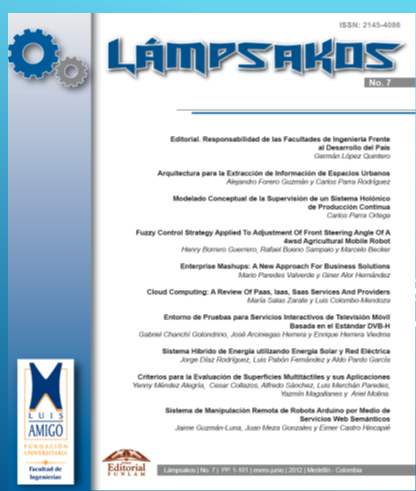Fuzzy Control Strategy Applied to Adjustment of Front Steering Angle of a 4WSD Agricultural Mobile Robot
DOI:
https://doi.org/10.21501/21454086.842Palabras clave:
Ackerman geometry, fuzzy controller, Two-Track Vehicle, Lateral dynamics, mobile robot, bike model, steering angle.Resumen
This paper presents the preliminary studies of the control strategy based in fuzzy logic, projected for the steering system of AGRIBOT project that consist of a wheeled autonomous mobile robotic in real scale endowed with four independent steering and driven wheels (4WSD). In this work we present a preliminary fuzzy controller design applied to front steering angle, using a multivariable plant which incorporates simplified linear model of lateral dynamics of a vehicle whose input are linear combination of rear and front steering angles. The fuzzy control strategy was decided because provides flexible way to deploy with embedded systems. Simulations are used to illustrate the designed controller performance. We use Ackerman geometry to trace front steering angle that allows the vehicle to perform correctly a given maneuver preserving a minimum level of stability and maneuverability. The goal is to establish a relationship between steering input commands and the control commands to the actuators so that it is possible to adjust the attitude of the actuators over the movement axis, as the trajectory change.Descargas
Referencias
Heraud, J., Lange, A., 2009, “Agricultural Automatic Vehicle Guidance from Horses to GPS: How We Got Here, and Where We Are Going”, ASABE Distinguished Lecture #33, pp. 1-67, Agricultural Equipment Technology Conference February 8-11, Louisville, Kentucky, USA.
Sigrimis, N., Antsaklis, P., Groumpos, P.P.,2010, “Advances in control of agriculture and the environment,” Control Systems, IEEE , vol.21, no.5, pp.8-12, Oct 2001.Singapore.
UNIBOTS., http://www.unibots.com/Agricultural_ Robotics_Portal.htm, accesed in Jan. 2011.
Bak, T., Jakobsen, H., 2009 “Agricultural Robotic Platform with Four Wheel Steering for Weed Detection”, Biosystems Engineering, Volume 87, Issue 2, February 2004, Pages 125-136.
Bakker, T. “An autonomous robot for weed control”, design, navigation and control”, PhD thesis - Wageningen University.
Tangerino, G., Godoy, E., Tabile, R., Souza, R., Inamasu, R., 2011, “Controle de Esterçamento de Robô Agrícola Móvel de Quatro Rodas Guiáveis”, X Simpósio Brasileiro de Automação Inteligente (SBAI).
Vilaplana, M., Leith, D., Leithead, W., Kalkkuhl, J, 2003, “Control of Sideslip and Yaw Rate in 4-Wheel Steering Cars Using Partial Decoupling and Individual Channel Design”, Proceedings of the European Control Conference 2003, 1-4 September 2003,Cambridge, UK. The IEE.
Rajamani, R., 2005 “Vehicle Dynamics and Control”, Springer-Verlag, 2005.
Manning, J., Crolla, D., 2007, “A review of Yaw Rate and Sideslip Controllers for Passenger Vehicles”, Transactions of the institute of measurement and control, pp. 117–135.
Sivanandam, S., Sumathi., Deepa, S., 2007, “Introduction to Fuzzy Logic using MATLAB”, Springer-Verlag Berlin Heidelberg.
Hakima, A., Ameli, S., 2010, “ Designing a Fuzzy Logic Controller to Adjust theAngle of Tires in Four Wheel Steering Vehicles”, 2010 11th Int. Conf. Control, Automation, Robotics and Vision, Singapure.
Zhang, J., Zhang Y., Chen L., Yang J., 2007 , “A fuzzy control strategy and optimization for four wheel steering system,” Vehicular Electronics and Safety, 2007. ICVES. IEEE International Conference on , vol., no., pp.1-6, URL: http:// ieeexplore.ieee.org/stamp/stamp.jsp?tp=&arnu mber=4456359&isnumber=4456353.
Descargas
Publicado
Cómo citar
Número
Sección
Licencia
De conformidad con las normas nacionales e internacionales sobre derechos de autor, las políticas de publicación de la Universidad Católica Luis Amigó y de la revista Lámpsakos (indexada con ISSN: 2145-4086), yo(nosotros), manifiesto(amos):
1. El deseo de participar como articulista(s) y someter a las normas editoriales establecidas por la revista (nombre la revista) el artículo titulado (nombre del artículo),
2. El compromiso de no retirar el artículo hasta no terminar el proceso de edición del número de la revista en curso.
3. Que el artículo es original e inédito y no ha sido postulado o presentado conjuntamente en otra(s) revista(s); por tanto, los derechos del artículo en cuestión no han sido cedidos con antelación y sobre ellos no pesa ningún gravamen ni limitación en su uso o utilización.
4. La inexistencia de conflicto de interés con institución o asociación comercial de cualquier índole.
5. Haber incorporado las citas y referencias de otros autores, tendientes a evitar el plagio. En consecuencia, afirmo que de ser publicado el artículo, no se violarán derechos de autor, de propiedad intelectual o de privacidad de terceros. Así mismo, de ser necesario, existe forma de evidenciar los permisos respectivos sobre derechos de autor originales para los aspectos o elementos extraídos de otros documentos como textos de más de 500 palabras, tablas, gráficas, entre otros. En caso de presentarse cualquier tipo de reclamación o acción por parte de un tercero en cuanto a los derechos de autor sobre el artículo, el(los) autor(es) asumirán toda la responsabilidad, y saldrán en defensa de los derechos aquí cedidos. Por tanto, para todos los efectos, la revista Lámpsakos de la Fundación Universitaria Luis Amigó actúa como un tercero de buena fe.
6. Que en el evento de publicarse el artículo, cedo(emos) a título gratuito y con carácter de exclusividad la integridad de los derechos patrimoniales así como los derechos de impresión, reimpresión y de reproducción por cualquier forma y medio, sin ninguna limitación en cuanto a territorio se refiere, en favor de la revista Lámpsakos de la Universidad Católica Luis Amigó.
7. Reconocer como coautores y/o colaboradores, a todos quienes participaron en ese rol y no se ha omitido a ninguno.








